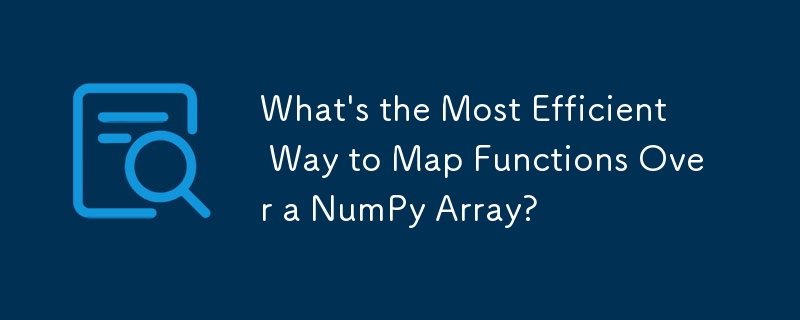

Efficient Numpy Array Mapping Strategies
When it comes to mapping functions over a Numpy array, performance efficiency is crucial. One fundamental question arises: "What is the most efficient approach for mapping operations?"
Inefficient Approach: Python List Comprehension
The example provided in the question utilizes a list comprehension:
squares = np.array([squarer(xi) for xi in x])
While this approach works, it has inherent inefficiencies due to the intermediate conversion from a Python list back to a Numpy array.
Optimized Strategies
Testing various methods, the optimal solutions emerge:
1. Use Built-in Numpy Functions:
If the function you're mapping is already vectorized in Numpy (e.g., x^2), using it directly offers superior performance:
squares = x ** 2
2. Vectorization with numpy.vectorize:
For custom functions, vectorization with numpy.vectorize shows significant speed gains:
f = lambda x: x ** 2 vf = np.vectorize(f) squares = vf(x)
3. numpy.fromiter:
This approach creates an iterator from the function and uses numpy.fromiter to efficiently construct a Numpy array:
squares = np.fromiter((squarer(xi) for xi in x), x.dtype)
4. numpy.array(list(map(...)):
Another optimized alternative is to use map and then convert it to a Numpy array:
squares = np.array(list(map(squarer, x)))
Benchmarks conducted using perfplot demonstrate that these optimized methods outperform the original list comprehension approach by a significant margin.
The above is the detailed content of What's the Most Efficient Way to Map Functions Over a NumPy Array?. For more information, please follow other related articles on the PHP Chinese website!
 What is ESD file?
What is ESD file?
 What is the article tag used to define?
What is the article tag used to define?
 How to solve parsererror error
How to solve parsererror error
 How to solve the problem of black screen after turning on the computer and unable to enter the desktop
How to solve the problem of black screen after turning on the computer and unable to enter the desktop
 How to configure jsp virtual space
How to configure jsp virtual space
 Complete collection of SQL query statements
Complete collection of SQL query statements
 what is css
what is css
 what is adobe flash player
what is adobe flash player




